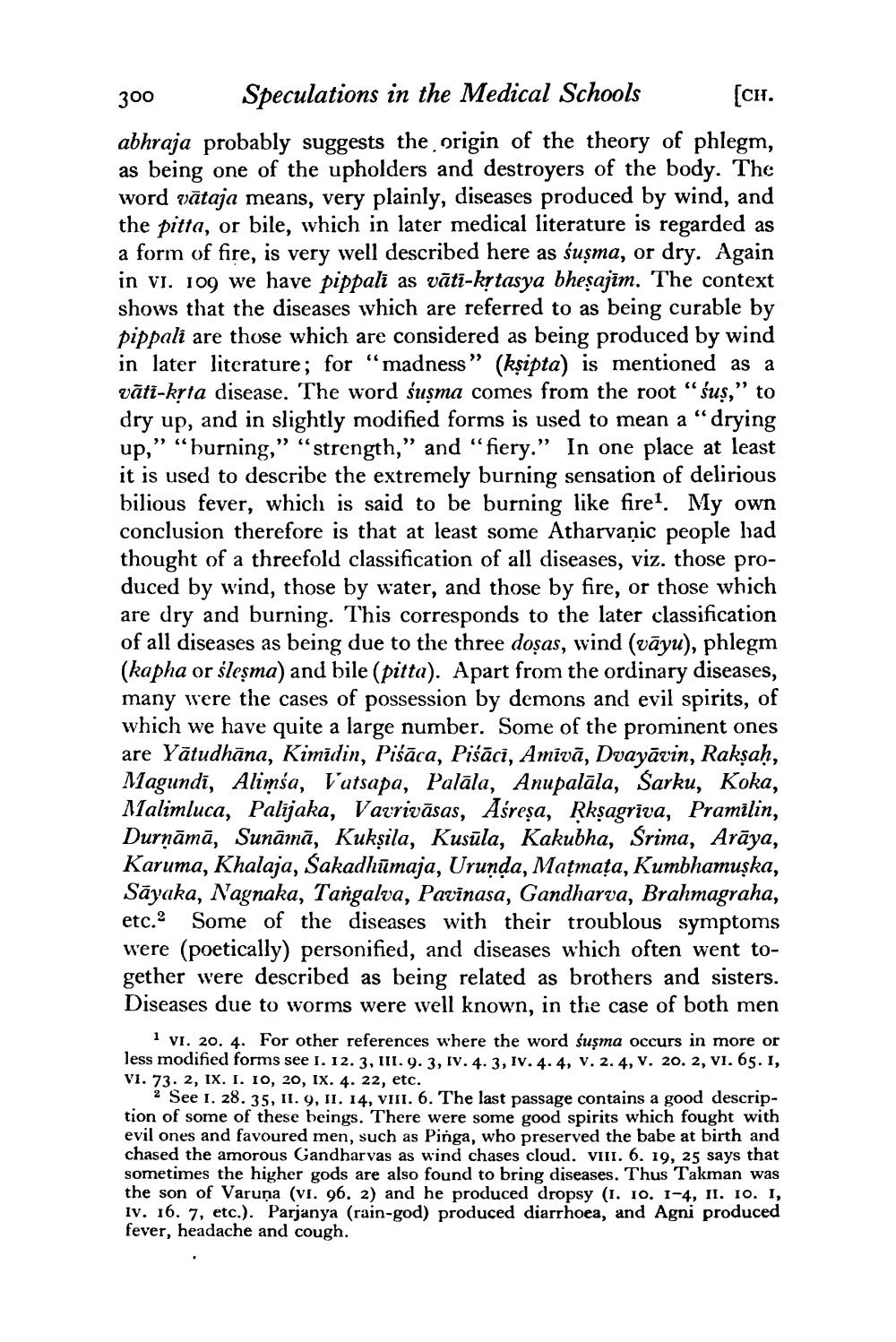________________
300
Speculations in the Medical Schools
[CH.
abhraja probably suggests the origin of the theory of phlegm, as being one of the upholders and destroyers of the body. The word vätaja means, very plainly, diseases produced by wind, and the pitta, or bile, which in later medical literature is regarded as a form of fire, is very well described here as śuşma, or dry. Again in VI. 109 we have pippali as vati-kṛtasya bheṣajim. The context shows that the diseases which are referred to as being curable by pippali are those which are considered as being produced by wind in later literature; for "madness" (kṣipta) is mentioned as a vāti-kṛta disease. The word suşma comes from the root "sus," to dry up, and in slightly modified forms is used to mean a "drying up," "burning," "strength," and "fiery." In one place at least it is used to describe the extremely burning sensation of delirious bilious fever, which is said to be burning like fire1. My own conclusion therefore is that at least some Atharvanic people had thought of a threefold classification of all diseases, viz. those produced by wind, those by water, and those by fire, or those which are dry and burning. This corresponds to the later classification of all diseases as being due to the three doșas, wind (vāyu), phlegm (kapha or sleṣma) and bile (pitta). Apart from the ordinary diseases, many were the cases of possession by demons and evil spirits, of which we have quite a large number. Some of the prominent ones are Yātudhāna, Kimīdin, Piśāca, Piśācī, Amīvā, Dvayāvin, Rakṣaḥ, Magundi, Alimsa, Vatsapa, Palāla, Anupalāla, Sarku, Koka, Malimluca, Palijaka, Vavrivāsas, Aśreṣa, Ṛkṣagriva, Pramilin, Durṇāmā, Sunāmā, Kukṣila, Kusula, Kakubha, Śrima, Arāya, Karuma, Khalaja, Šakadhūmaja, Urunda, Matmata, Kumbhamuşka, Sayaka, Nagnaka, Tangalva, Pavinasa, Gandharva, Brahmagraha, etc.2 Some of the diseases with their troublous symptoms were (poetically) personified, and diseases which often went together were described as being related as brothers and sisters. Diseases due to worms were well known, in the case of both men
1 VI. 20. 4. For other references where the word śuşma occurs in more or less modified forms see 1. 12. 3, III. 9. 3, IV. 4. 3, IV. 4. 4, V. 2. 4, V. 20. 2, VI. 65. I, VI. 73. 2, IX. I. 10, 20, IX. 4. 22, etc.
2 See 1. 28. 35, II. 9, II. 14, vIII. 6. The last passage contains a good description of some of these beings. There were some good spirits which fought with evil ones and favoured men, such as Pinga, who preserved the babe at birth and chased the amorous Gandharvas as wind chases cloud. VIII. 6. 19, 25 says that sometimes the higher gods are also found to bring diseases. Thus Takman was the son of Varuna (vI. 96. 2) and he produced dropsy (1. 10. 1-4, II. 10. I, IV. 16. 7, etc.). Parjanya (rain-god) produced diarrhoea, and Agni produced fever, headache and cough.




